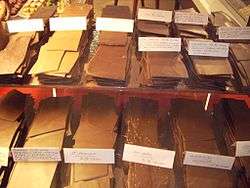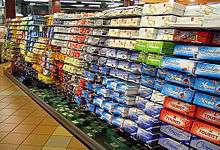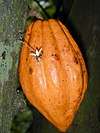Swiss chocolate
 A chocolate display in Neuchâtel | |
| Place of origin | Switzerland |
|---|---|
| Main ingredients | Chocolate |


Swiss chocolate is chocolate produced in Switzerland. While cacao beans and other ingredients such as sugar can originate from outside Switzerland, the actual production of the chocolate must take place in Switzerland. Switzerland's chocolates have earned an international reputation for high quality with many famous international chocolate brands.
Switzerland is particularly renowned for its milk chocolate. In 1875, a Swiss confectioner, Daniel Peter, developed the first solid milk chocolate using condensed milk, which had been invented by Henri Nestlé, who was Peter's neighbour in Vevey.[1][2]
History
The 17th century saw the start of chocolate processed in Switzerland. In the 18th century chocolate was only produced in a few areas, such as the Ticino.
In the 19th and early-20th centuries the following chocolate factories were founded:
- 1819 - Cailler in Vevey (today Nestlé)
- 1826 - Favarger in Versoix, Canton of Geneva
- 1826 - Suchard in Serrières (today Kraft Foods)
- 1830 - Kohler in Lausanne (today Nestlé)
- 1836 - Sprüngli in Zurich, company split into Confiserie Sprüngli and Lindt & Sprüngli in 1892
- 1852 - Maestrani in Luzern (today in Flawil)
- 1862 - Klaus in Le Locle
- 1867 - Peter in Lausanne (today Nestlé)
- 1879 - Lindt in Bern (today Lindt & Sprüngli)
- 1887 - Frey in Aarau (today Migros)
- 1899 - Tobler in Bern (today Kraft Foods)
- 1901 - Chocolat de Villars in Villars sur Glâne
- 1908 - Felchlin in Schwyz
- 1928 - Stella SA in Lugano (1987 Giubiasco)
- 1929 - Camille Bloch in Courtelary
- 1932 - Teuscher in a small town in the Swiss Alps
- 1932 - Bernrain in Kreuzlingen
- 1933 - Chocolats Halba in Wallisellen
- 1934 - Kägi Söhne AG in Toggenburg
In the second half of the 19th century Swiss Chocolate started to spread abroad. Closely linked to this was the invention of Milk Chocolate by Daniel Peter in Vevey and the invention of the conching by Rodolphe Lindt.
.jpg)
Sales market
From the 19th century until the First World War and throughout the Second World War the Swiss chocolate industry was very export-oriented. After the Second World War Switzerland began to outsource production due to commercial restrictions.
Today most Swiss chocolate is consumed by the Swiss themselves (54% in 2000), and Switzerland has the highest per capita rate of chocolate consumption worldwide (11.6 kg (25.6 lbs.) per capita per annum).
In 2004 148,270 tonnes of chocolate were produced in Switzerland. 53% of this was exported (20% to Germany, 11% to France and Great Britain and 13% to North America). The gross income of the Swiss chocolate industry in 2004 was 1.37 billion CHF (814 million from the local market, 551 million from exports).
Industry structure
In 1901 Swiss chocolate producers created the Union libre des fabricants suisses de chocolat . In 1916, this was divided into the Chambre syndicale des fabricants suisses de chocolat and the Convention chocolatière suisse. The former "Chambre syndicale" (today the Chocosuisse) protects the interests of Swiss chocolate producers. The "Convention chocolatière" focused on the quality of the chocolate and sought a uniform price strategy. In 1994 the Convention was disbanded.
See also
References
Much of the content of this article comes from the equivalent German-language Wikipedia article (retrieved October 10, 2006). The following references are cited by that German-language article:
- Alain J. Bourgard: CH comme Chocolat, 2003, ISBN 2-8321-0036-8
- Specific
- ↑ Mintz, Sidney (17 April 2018). "The Oxford Companion to Sugar and Sweets". Oxford University Press. p. 524 – via Google Books.
- ↑ Moskin, Julia (13 February 2008). "Dark may be king, but milk chocolate makes a move". The New York Times. Archived from the original on 14 May 2016. Retrieved 1 January 2016.
External links
| Wikimedia Commons has media related to Chocolate of Switzerland. |
